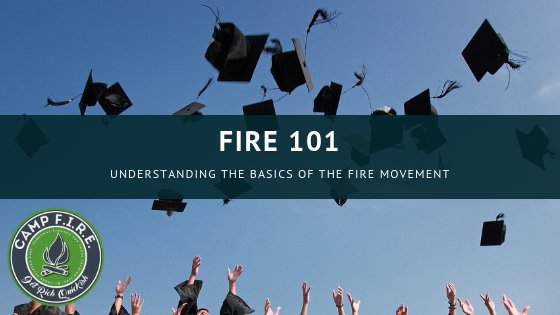FIRE 101. Understanding the Basics of the FIRE Movement
Financial Independence and Early Retirement, commonly referred to as FIRE, isn’t a complicated concept. But there are some nuances within the FIRE Movement that need a bit of clarification.
Things like the Rule of 25, Fat FIRE, the Safe Withdraw Rate (a.k.a. the 4% Rule) are all important variables that we attempt to clarify with the following six FIRE articles.
Consider this FIRE 101! Those that read these articles should come away with a solid understand of what FIRE is and how it works … and you just might be able to shave decades off your working career as well.
About The FIRE Movement

FIRE stands for Financial Independence Retired Early. One is considered to be FIRE when living expenses are covered by investment returns.
But FIRE is more than a math problem.
A Newbie’s Guide to FIRE

Using the Rule of 25 and the 4% Rule to figure out your retirement numbers is simple enough. But new FIRE definitions like Fat FIRE and Lean FIRE keep popping up. But not to worry! Our Newbie’s Guide to Understanding FIRE Finance has got you covered.
The Rule of 25

The Rule of 25, also know as the Multiply by 25 Rule, attempts to define how much money you’ll need to save for your retirement. Not surprisingly, based on its name, that amount is 25 times your annual expenses (not income).
The 4% Rule

The 4% Rule is a foundational component of the FIRE Movement. But what is the 4 Percent Rule and how does it work? Can an early retiree use this rule of thumb to plan for a retirement that could last 60 years or more?
FIRE Milestones

Achieving FIRE might seem like an impossible goal at first, but it’s not an all or nothing deal. There are several noteworthy steps along the way to financial independence that are worthy of celebration.
Funding Early Retirement

Did you know that every $350 per month that you can eliminate from your budget reduces the amount you need to save for retirement by $100,000? Learn how to calculate retirement costs for anything.
FIRE FAQs
These are the most frequently asked FIRE questions
WHAT IS FIRE FINANCE, AND HOW DOES FIRE FINANCE WORK?
FIRE finance is the math early retirees use to to build early retirement portfolios, and to calculate how much of that portfolio they can be spent each year without ever running out of money.
Two financial rules of thumb make FIRE finance work: the Rule of 25 and the 4% Rule.
WHAT IS THE 4% RULE?
The 4% Rule is based on two financial averages. First, the 4 Percent Rule says that your stock portfolio will grow at an average rate of 7% annually. Second, because the average rate of inflation is 3%, the idea is that you can safely withdraw 4% of that growth, leaving 3% behind to keep up with inflation.
Because you’re only spending the average incremental growth from your portfolio, in theory you should never run out of money.
WHAT IS THE RULE OF 25?
The Rule of 25, also know as the Multiply by 25 Rule, attempts to define how much money you’ll need to save for your retirement.
Not surprisingly, based on the name of the rule, that amount is 25 times your annual expenses (not income).
CAN ANYBODY ACHIEVE FIRE?
Tough question. Not everyone can, or should, pursue early retirement, but everyone should make financial independence a goal.
FIRE might be easier to reach for the well-to-do, but FIRE offers something for everyone, regardless of income, and anyone that says otherwise doesn’t fully understand The FIRE Movement.
HOW DO I GET STARTED?
It would be great if there were a step-by-step approach to financial independence, but that’s not the case. Every situation is uniquely different, therefore you’ll need to customize your strategy to fit your needs.
That’s why, in our opinion, the best first step you can take is anything. It doesn’t matter what you do to start improving your financial situation, what’s important is that do something to improve your financial situation. You can always evolve your strategy later.

